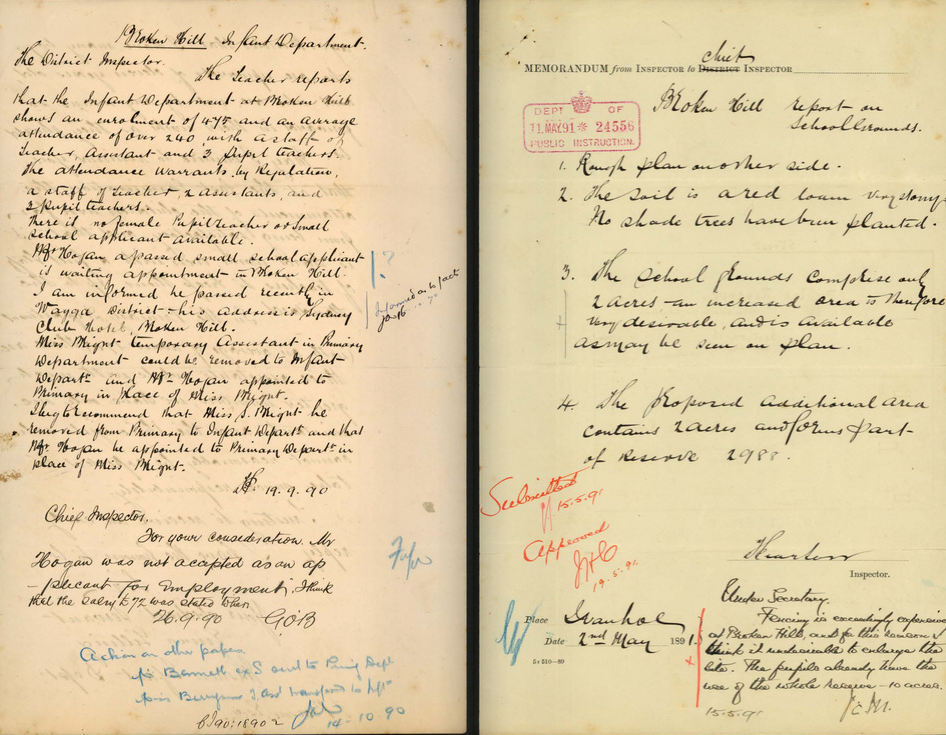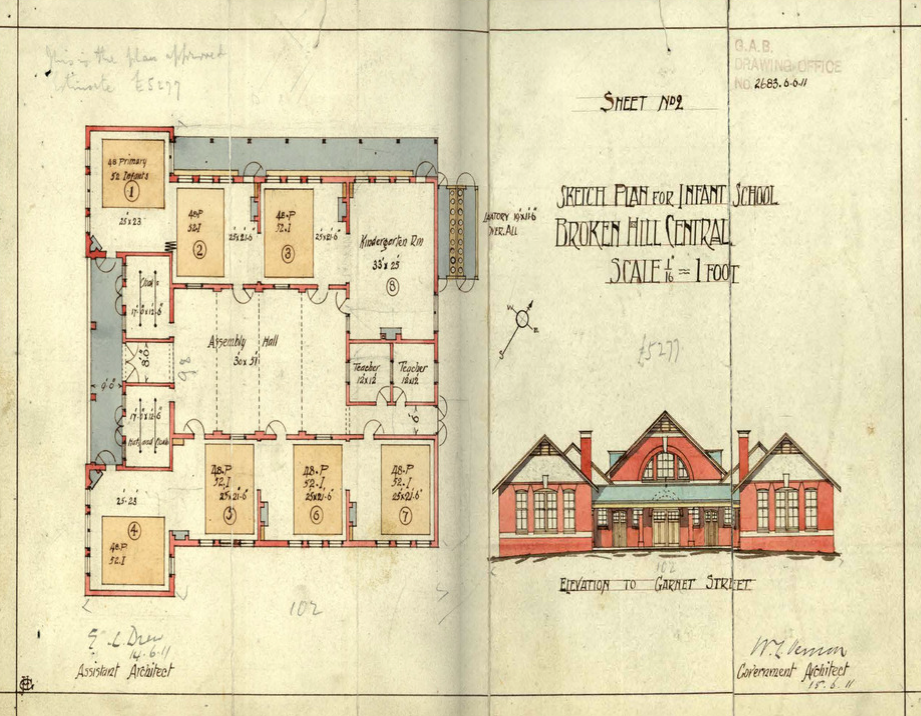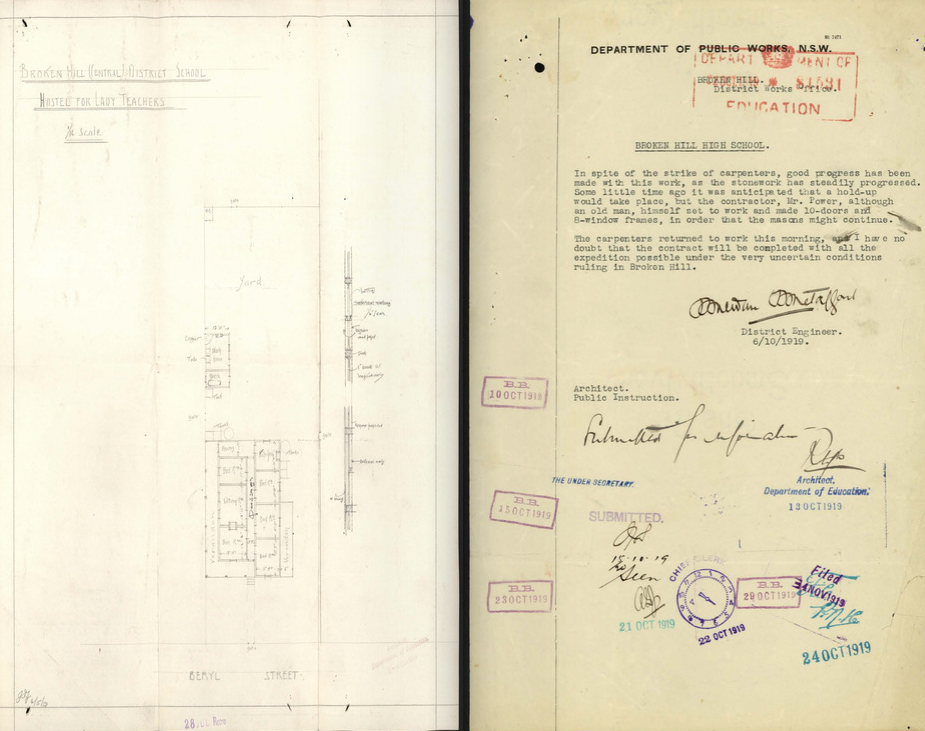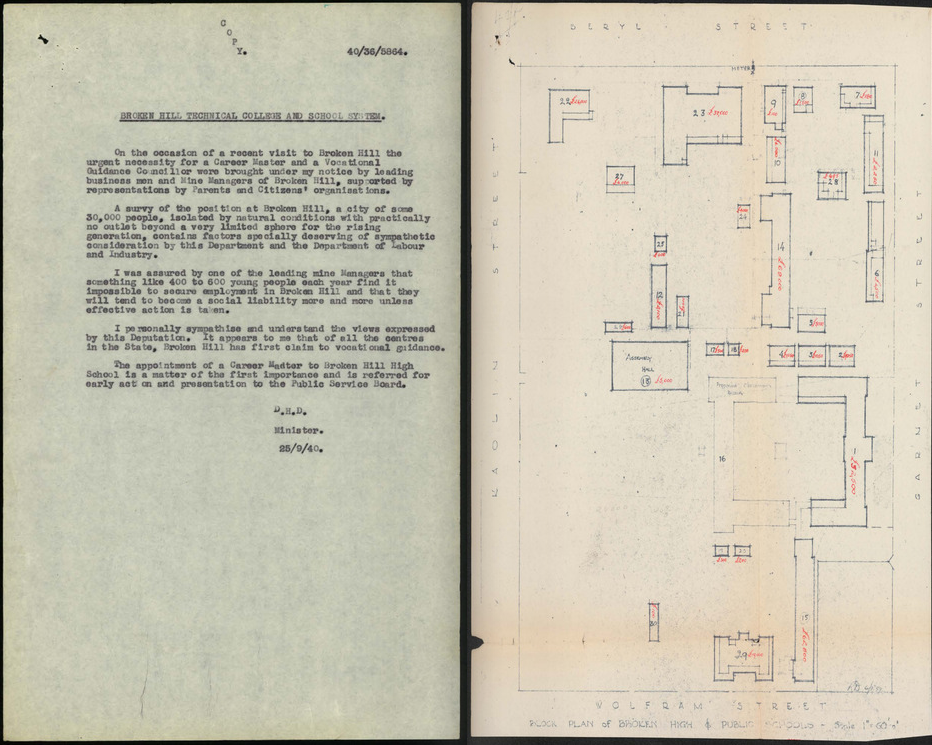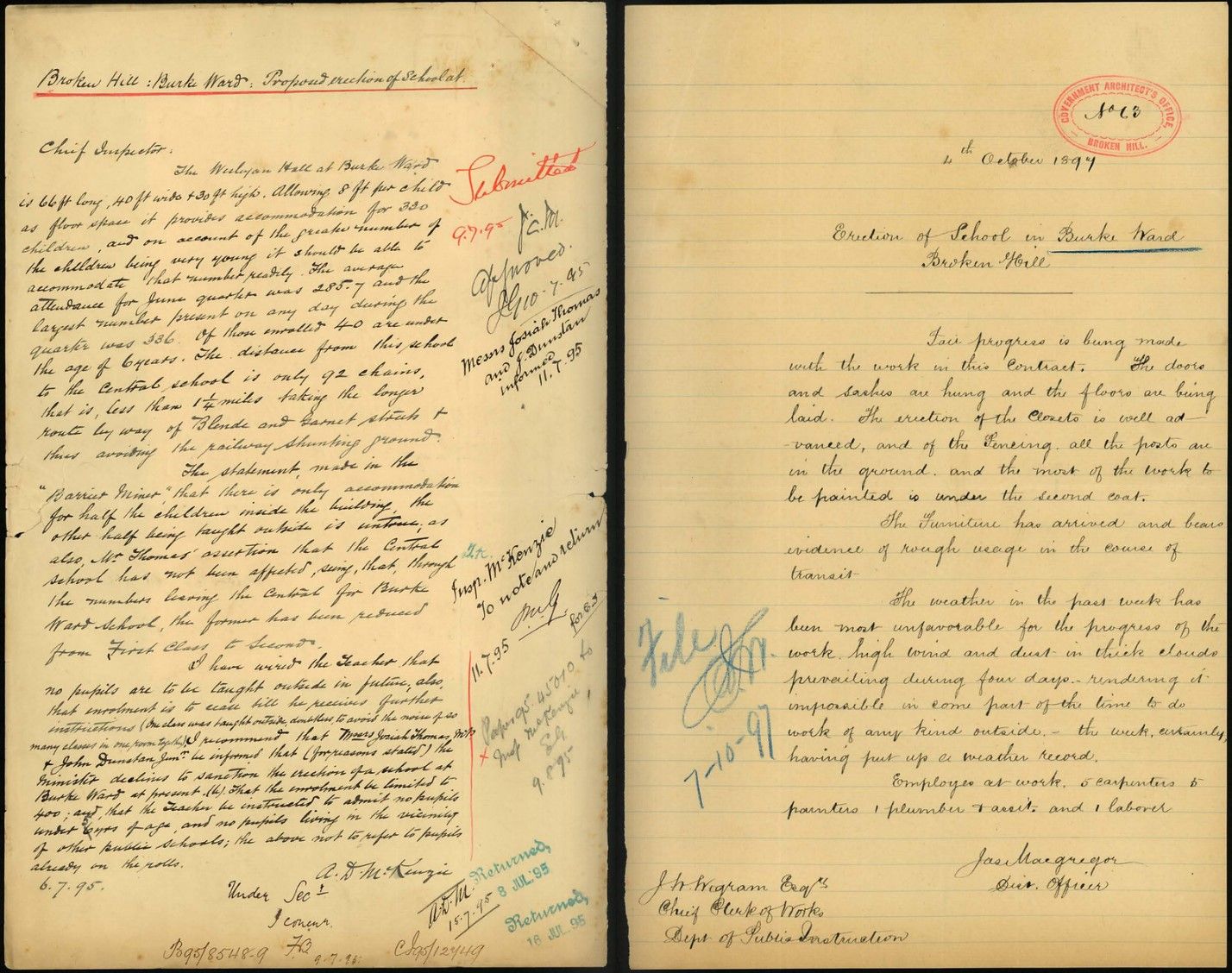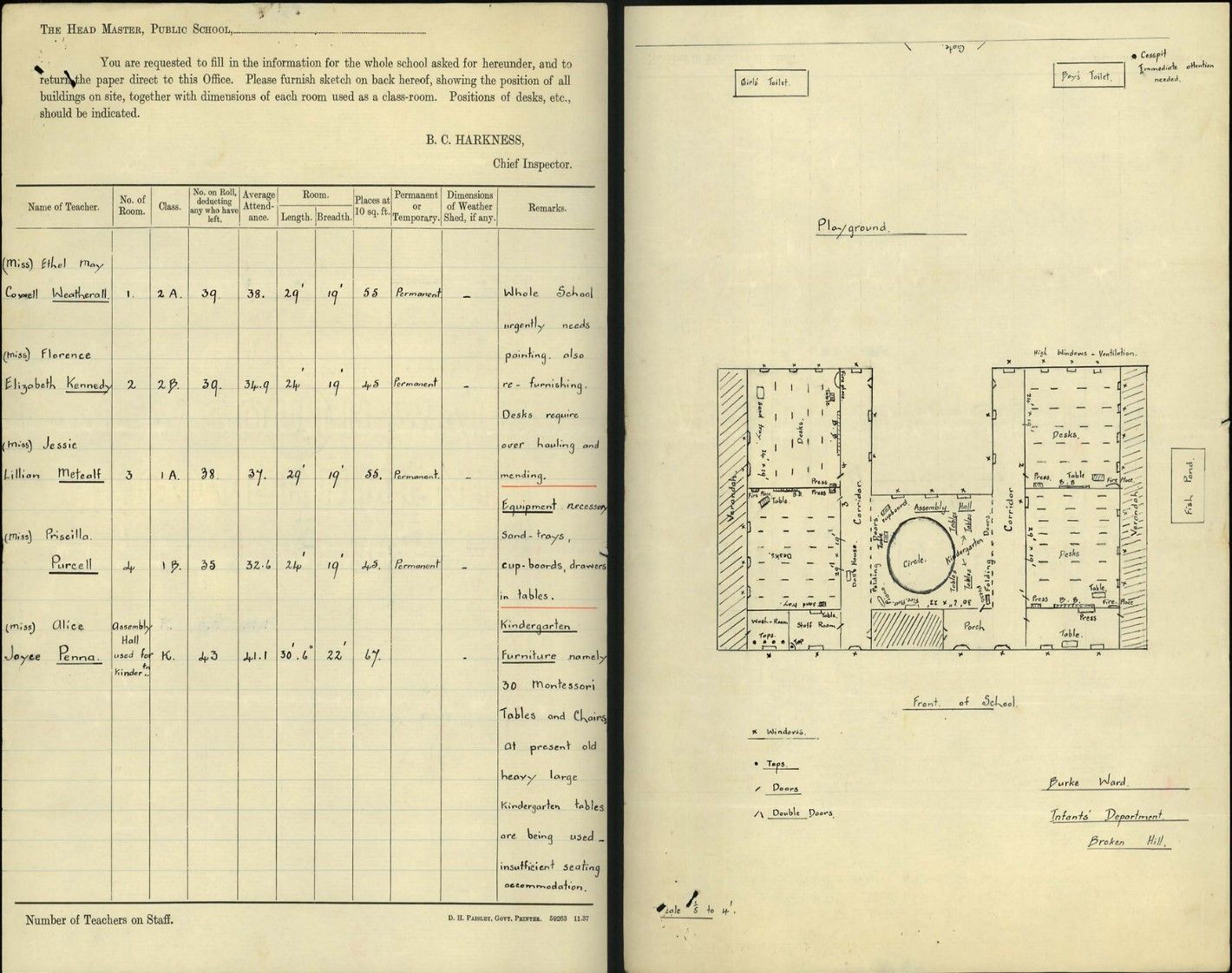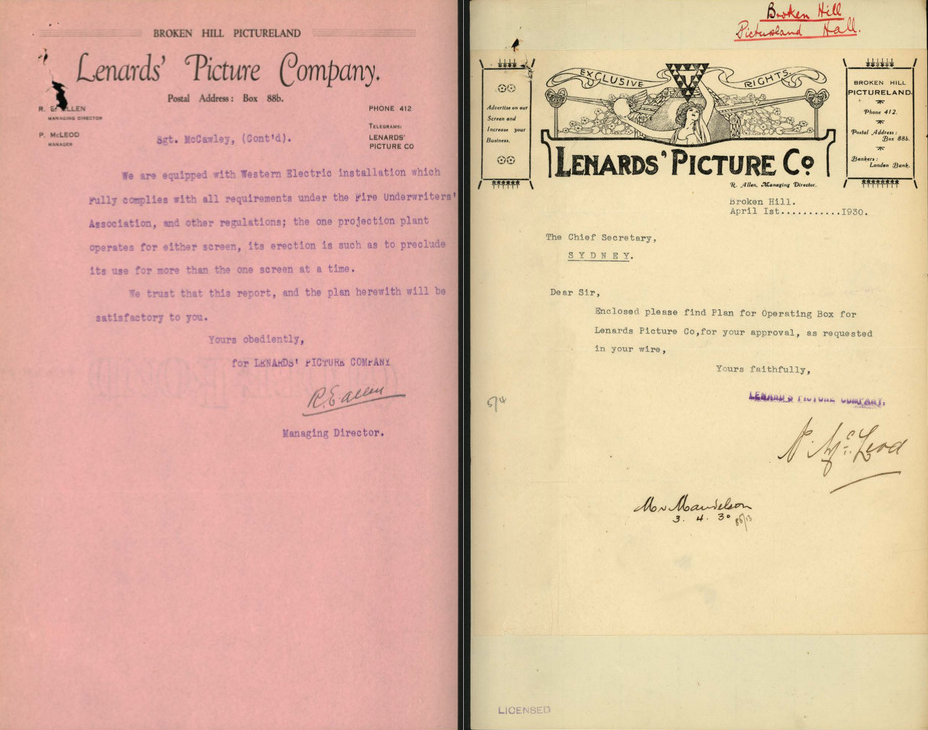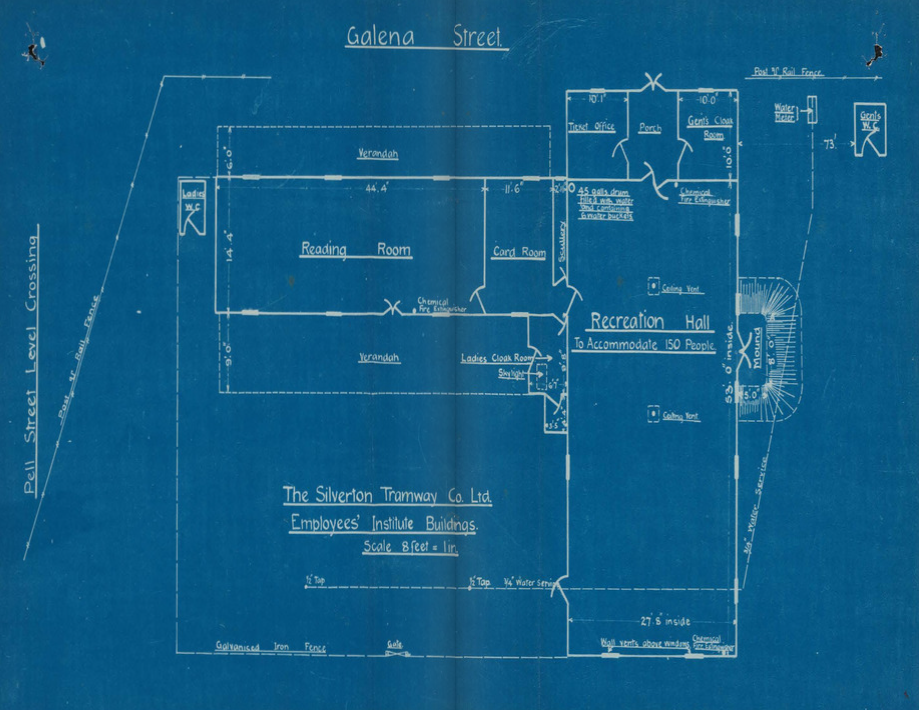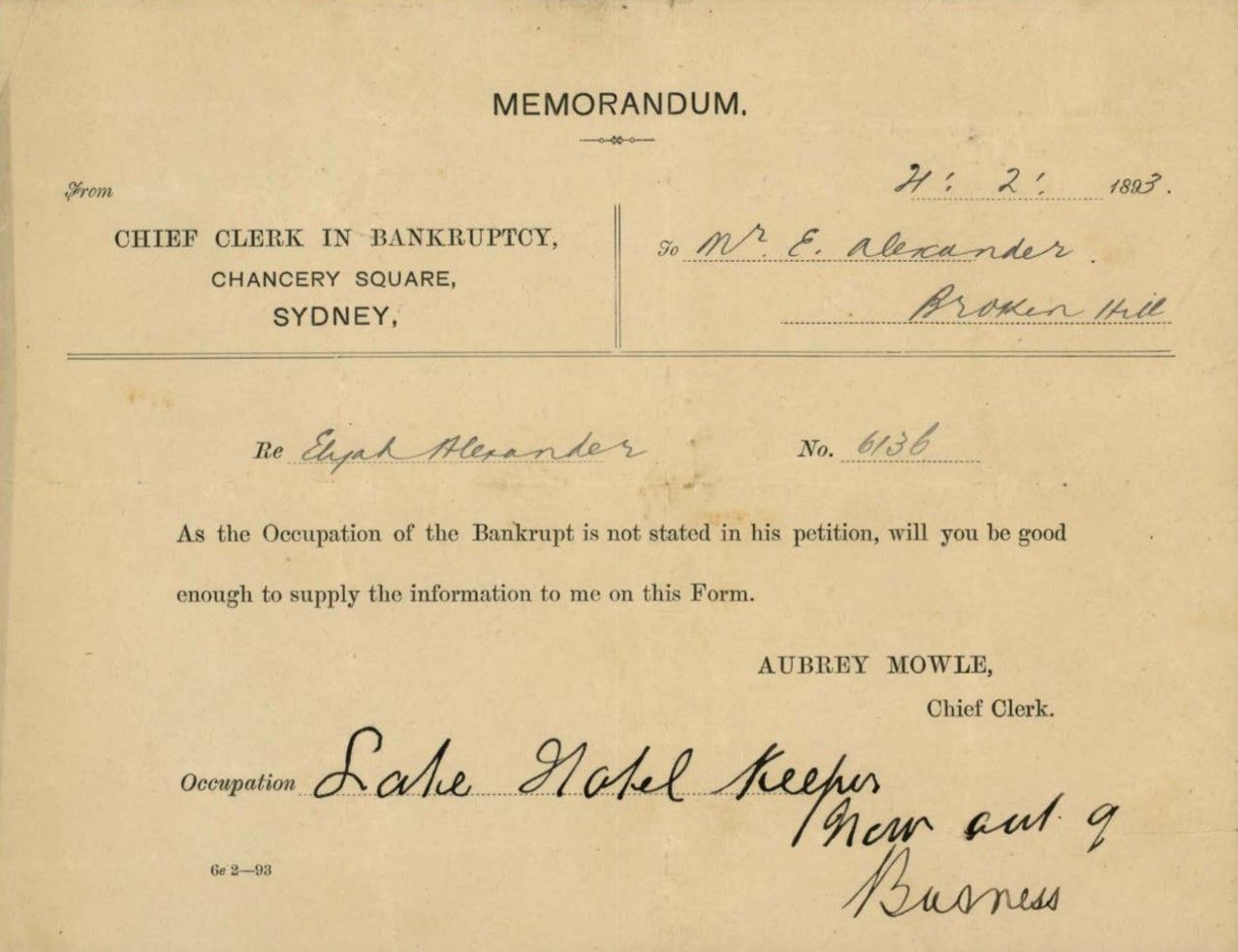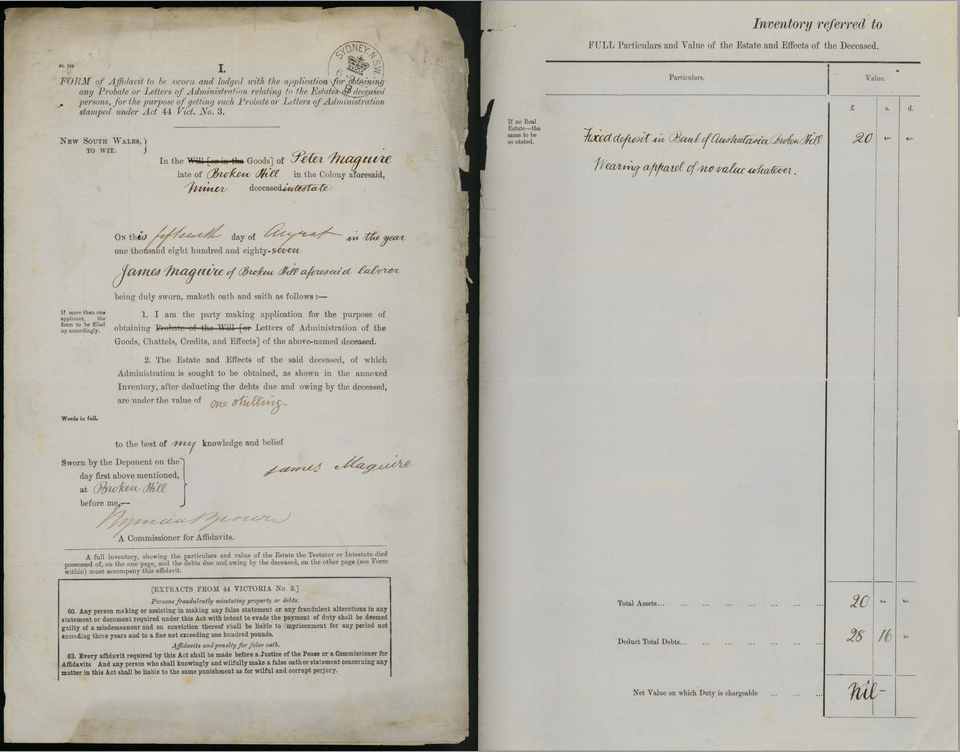Broken Hill
As part of our Archives on Tour initiative we conducted a virtual tour of some of the archives that highlight key moments and people from Broken Hill's past. Take a tour of some of the featured archives below.
Watch the recording of the virtual event and come behind the scenes
1:10:46
3:48
1:54
4:39
3:32
School Files, 1876-1979
[NRS-3829]
What can they tell you about your town?
There are similarities between all of the school files through content and purpose. They reflect their times. The files cover both wars but particularly reflect the many impacts of World War 1. Women resign or are terminated when they marry as married women were barred from public sector employment. Schools very strongly reflect the growth or decline of towns.
Broken Hill’s School files
The School files show the commencement and growth of the government school system from the first Broken Hill school in 1886 - Broken Hill Public School. Additional public schools opened in 1889 (Alma), 1890 (Broken Hill North) and 1895 (Burke Ward).Broken Hill Public School and Broken Hill North Public School offered secondary schooling until Broken Hill High School was established in 1920. More public schools started in the 20th century and a second high school.
Petitions for new schools were generally successful though two petitions were needed before Burke Ward was established and it started in a rented Wesleyan hall. A petition for a school in Broken Hill West was not successful.
Additional school buildings and repairs to existing buildings are needed regularly. The Broken Hill climate and its impact on schooling is also raised regularly
Teachers return from war, underestimate the time required to reach Broken Hill, resign as they are getting married, speak out against conscription (in their own time), struggle to find accommodation, request additional staff, support Italian born high school students when Italy declares war on Great Britain in 1940, teach in hat rooms and on verandahs and are moved between Broken Hill schools to meet needs.
Parents and Citizens groups organise World War 1 honour rolls and school fetes and make representations in support of the schools.
As early as 1913 consideration was being given to a high school (see Tamworth High School’s School file). Despite a carpenters’ strike the High School opens in 1920.
School supplies are shipped via the SS Katoomba, the District Inspector was situated in Moama and the excitement of the early days of Broken Hill are reflected in the first school petitions.
20th century increases in population saw Infants children moved between schools to reduce class sizes, new public schools and a new high school established.
Extracts from the files
Plans of public buildings
[NRS-4335]
The Colonial Architect started in 1832 and continued on as the Government Architect to the end of the 20th century. The public buildings serve a variety of purposes including Land Board offices; pilot stations and light houses in coastal areas; schools; hospitals; police stations; gaols; court houses; and even post offices from before postal services became a Federal Government responsibility. All of these buildings are often large and enduring even if their purpose changes over time.
Broken Hill building plans
The plans of Broken Hill South Post and Telegraph Office from 1897 are from a time when postal and telegraph services were still the responsibility of New South Wales. The plans are signed by Government Architect Walter Vernon.
Broken Hill Tramway Block plan showing position of residence for officer-in-charge, 25/2/1902. The plans are from the Railway Construction Branch of the Public Works Department.
Plan of proposed additional office accommodation for officer-in-charge of Broken Hill Trams. Plans and elevations. Signature of architect (W. Keen) appears on the plan, 10/6/1903. The plans have a list of the furniture and a key to show its location in the office.
Theatres and public halls files, 1895-1992
Theatres and public halls had to be licensed from 1895. The licensing and regulations related to public safety. The theatres and public halls were owned by private individuals, businesses, religious organisations, community groups and councils and they were used for many purposes – dances; social gatherings; showing movies; live entertainment and skating (roller and ice). The files provide information about local businesses – both in relation to theatres and public halls and the construction industry. Theatres and public halls are a large part of recreation in any town. The rise and fall of these buildings chart changes in population and in the broader world of recreation.
The Ozone Theatre was in the block bounded by Chloride, Blende and Beryl Streets. Originally called Pictureland, it was considered a temporary structure before 1913. It had open air and enclosed areas. It became The Ozone Theatre in the mid 1930s. In 1959 movies were shown six nights a week. A fire on 24 December 1961 destroyed much of the building and it was demolished in 1963.
Burke Ward Institute Hall started as the Silverton Tramway Employees’ Club Recreation Hall on Galena Street in the late 1920s.The Silverton Tramway Employees’ Institute building also housed a card room and a meeting room. The hall was mainly used for dancing in the 1930s.The hall was managed by the Broken Hill City Council by 1970 and no longer required a licence.
Extracts from the files
Bankruptcy, 1888-1929
Bankruptcy is a state in which a person is unable to pay creditors and is required to undergo a legal process that usually results in liquidation of his/her estate in order to meet expenses (at least in part). If a person is declared to be a bankrupt then he/she cannot operate a business for profit, enter a business contract or borrow money. It is similar, but not identical to insolvency.
There are Insolvency files from 1842 to 1887 and from 1930 bankruptcy became a Federal government matter.
Bankruptcy files contain lists of creditors that the bankrupt person owed money to and debtors that owed money to the bankrupt person. Through these lists they show commercial connections in a town, between towns and with Sydney. The bankrupt person provides a statement about why they became bankrupt often providing a picture of what is happening in the town and beyond. The files of bankrupt people in the town collectively show what sorts of businesses where operating.
Records of a Broken Hill resident
Elijah Alexander was the licensee of the Freemasons Hotel in Broken Hill. A sequestration order was made against Elijah Alexander’s estate on 21 February 1893. Elijah Alexander took the licence of the hotel in October 1891.He attributed his bankruptcy to a range of causes – sickness in the family; the drought in 1891-1892; the Broken Hill strikes “by which my house was boycotted”; and losses on a contract to provide food for the “free workers” on the mines during the strike. Elijah Alexander had assets of over 54 pounds and liabilities of 2,480 pounds. The matter was complicated by the owners of the hotel taking action in court against Elijah Alexander.
Deceased estate files, 1880-1958
[NRS-13340]
The Stamp Duties Office created a deceased estate file for every individual who died leaving property or other assets ('estates'), which were subject to death duties. The files contain the papers, correspondence and other documentation relating to the assessment of death duty by the Stamp Duties Office. They are a financial record of the person’s estate when they die and frequently have very detailed information about a person’s possessions.
There are Deceased estate files for people from all walks of life, men and women, all ages and financial positions.
Records of Broken Hill Residents
These Deceased estate files from the 1887, 1949 and 1951 are typical of people of their time and their roles. All also have Probate packets.
Peter Maguire was a miner who died in Broken Hill in 1887. His brother James Maguire, also of Broken Hill, signed the affidavit. Peter Maguire did not make a will. Peter Maguire had 20 pounds and his wearing apparel and over 28 pounds in debts.
Adjib Khan was 75 and a pensioner when he died in 1949. He lived with his wife Veronica Khan at 758 Chapple Street. The land was held under Mining Tenement 514A. Adjib Khan had over 283 pounds of assets and 16 pounds of debts. Veronica Khan inherited the whole of her husband’s estate. Veronica Khan was 66 when she died in 1951 and still lived at 758 Chapple Street. She had had over 516 pounds of assets and 37 pounds of debts
Probate packets, 1817-1976 and part 1989
[NRS-13660]
A grant of probate is the authority given by the Supreme Court of NSW to the executor(s) to deal with a deceased person's estate. Probate packets hold the last will and testament, codicils (additions or revocations to the will) or letters of administration.
Other documents include an inventory of assets of the estate; affidavits of death and papers produced by the executor.
Not everyone has a probate packet. Depending on the type, size and value of the assets located in New South Wales it may not be necessary to obtain a grant of probate in New South Wales. There is no statutory requirement to obtain probate in every case.
Records of Broken Hill residents
These three Probate packets from the 20th century are typical of people of their time and their roles while also being special because of who they are.
William MacGillivray was a doctor in Broken Hill. His passion was birds and he travelled extensively in Australia to study birds and nature. In 1920, with Albert Morris, William MacGillivray helped to found the Barrier Field Naturalists' Club. Albert Morris served as its secretary until his death while William MacGillivray was President for 14 years.
William MacGillivray died in 1933 aged 67. His estate was worth over 11,000 pounds. There was a galvanised iron museum and wire netting enclosures and scientific collections (worth 250 pounds) at his home in Chloride Street. The detailed valuations of William MacGillivray’s general practice and the debts owed to the practice provide insight to a country doctor’s life.
Florence May Harding. May Harding died in 1971 in Broken Hill aged 63. May Harding was a teacher, naturalist, botanist, and artist. She also had a long association with the Barrier Field Naturalists' Club including as Secretary. For 40 years May Harding taught art and botany at the Broken Hill Technical College. May Harding was a foundation member, secretary, and treasurer of the Willyama Arts Society.
May Harding’s estate was worth $4,500 including her home at 59 Williams Street, modern appliances (washing machine and refrigerator) and a quantity of art works.
Dame Mary Gilmore died in 1962 after a life that spanned several continents and brought her fame. Her Australian Dictionary of Australia entry describes her as poet, writer, patriot, feminist, social crusader and folklorist. As Mary Cameron her first job was in teaching including two year as a temporary assistant teacher at Silverton. Over 70 years later, Mary Gilmore’s estate worth over 12,000 pounds was divided in detail in her 11 page will.
Published on
Local history
Browse all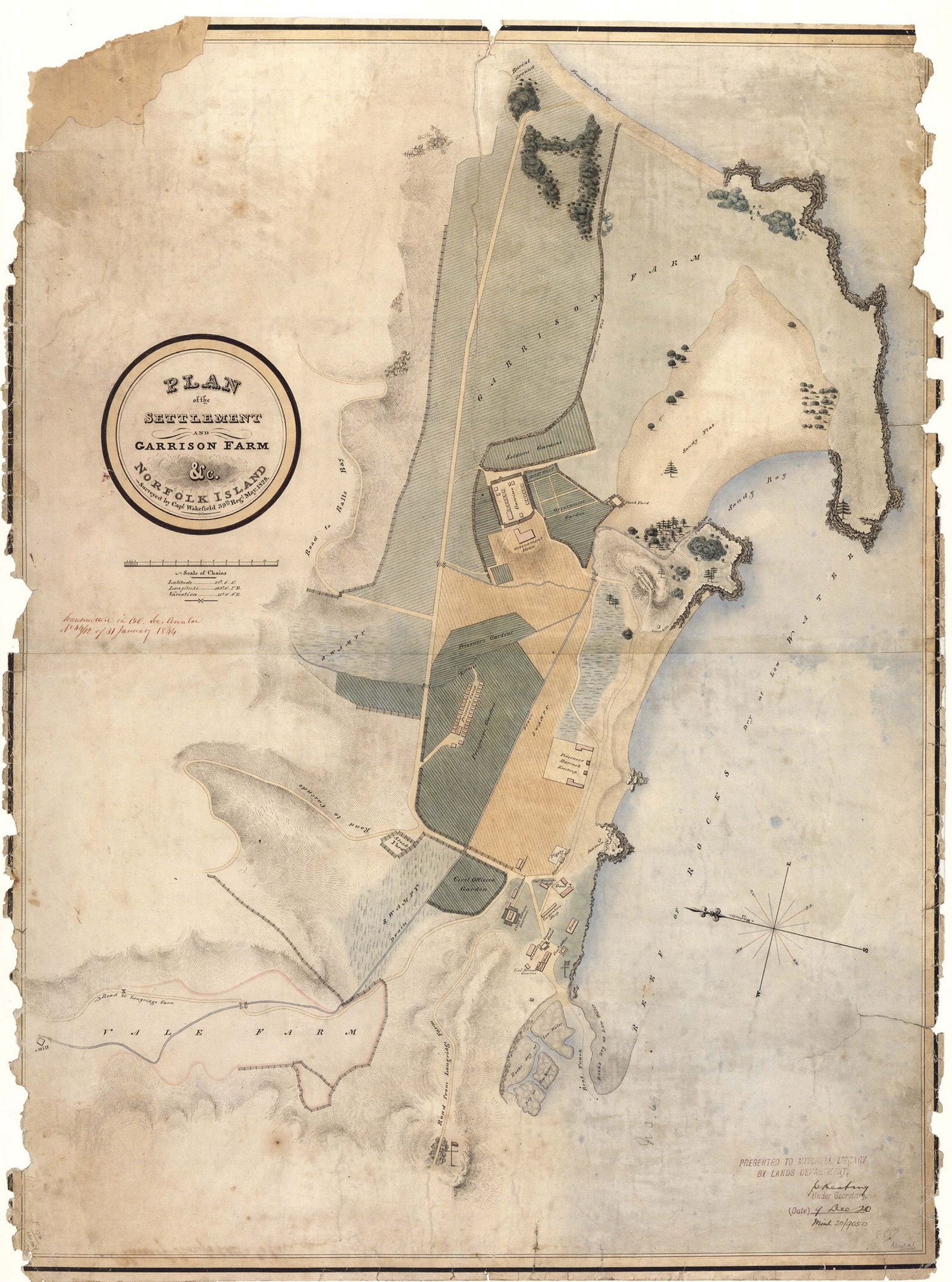
County & parish maps guide
An overview of county, parish and town/village maps created by the Department of Lands and its predecessors
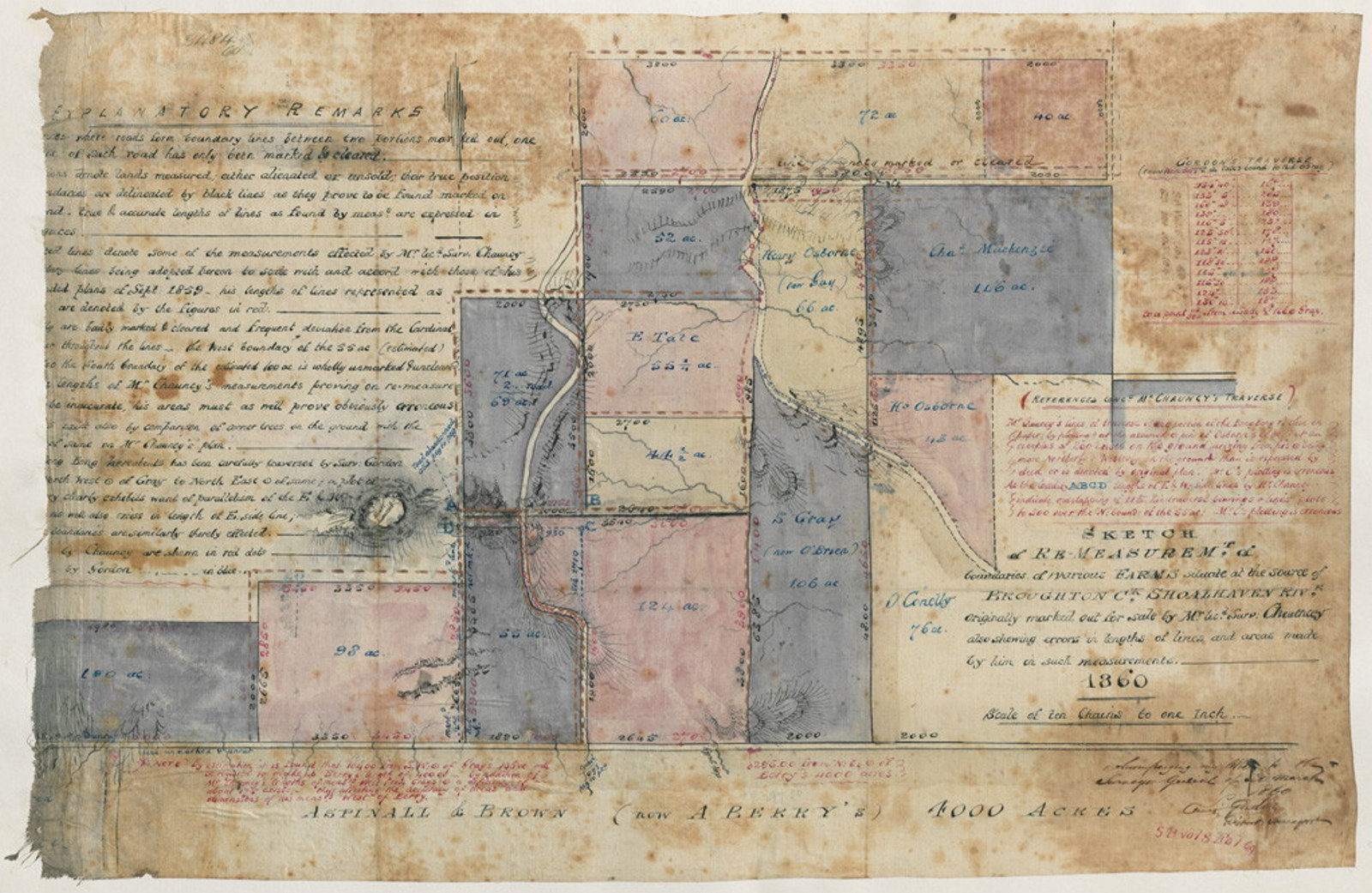
Court of Claims (Land) guide
This court resolved the claims of people who had been promised land grants but were not in possession of the titles, or where the land was in the possession of others claiming to have lawful right to it
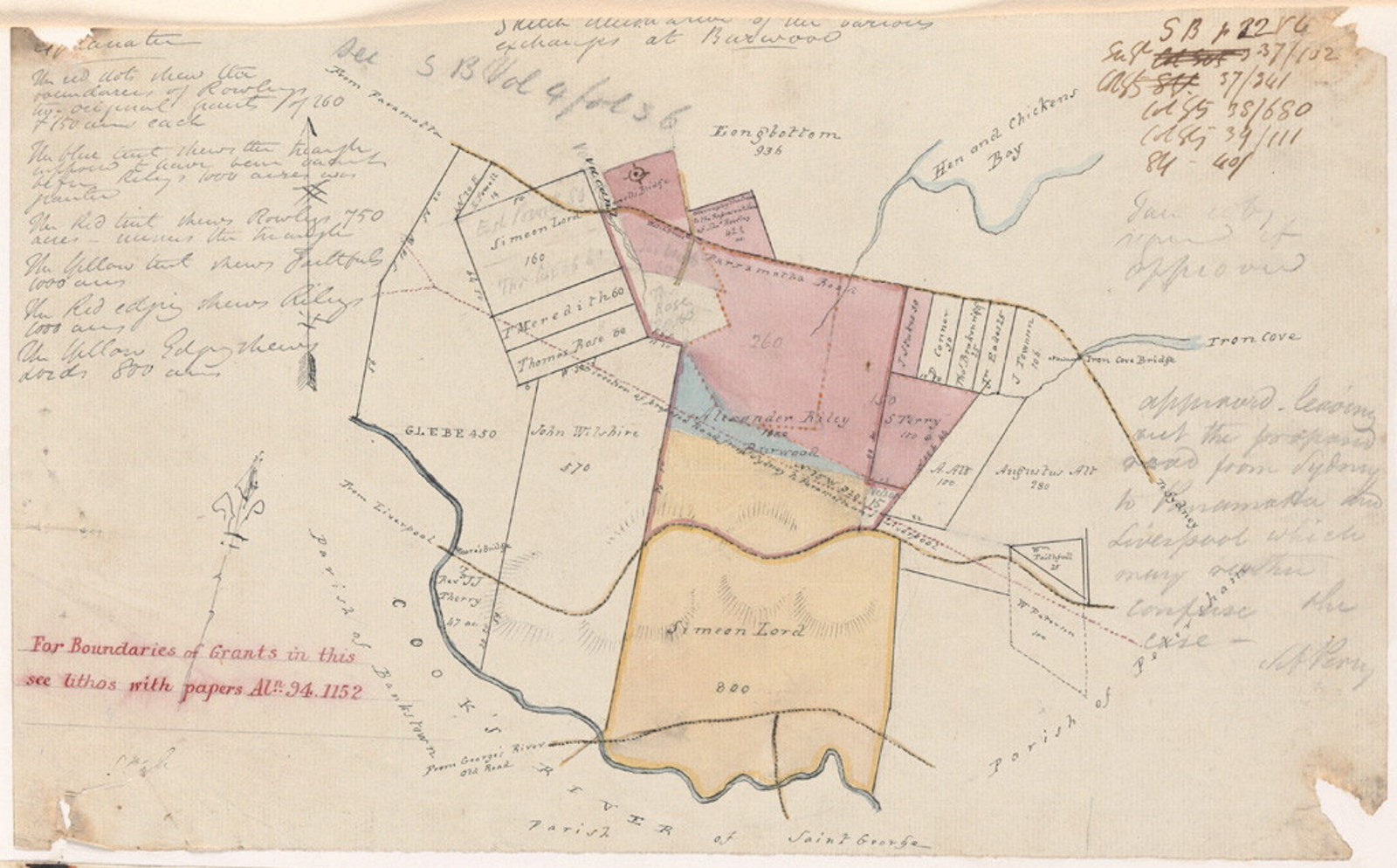
Land grants guide, 1788-1856
These records relate to the original alienation of land from the Crown. Parish maps are useful for research in this area, as they record original grants
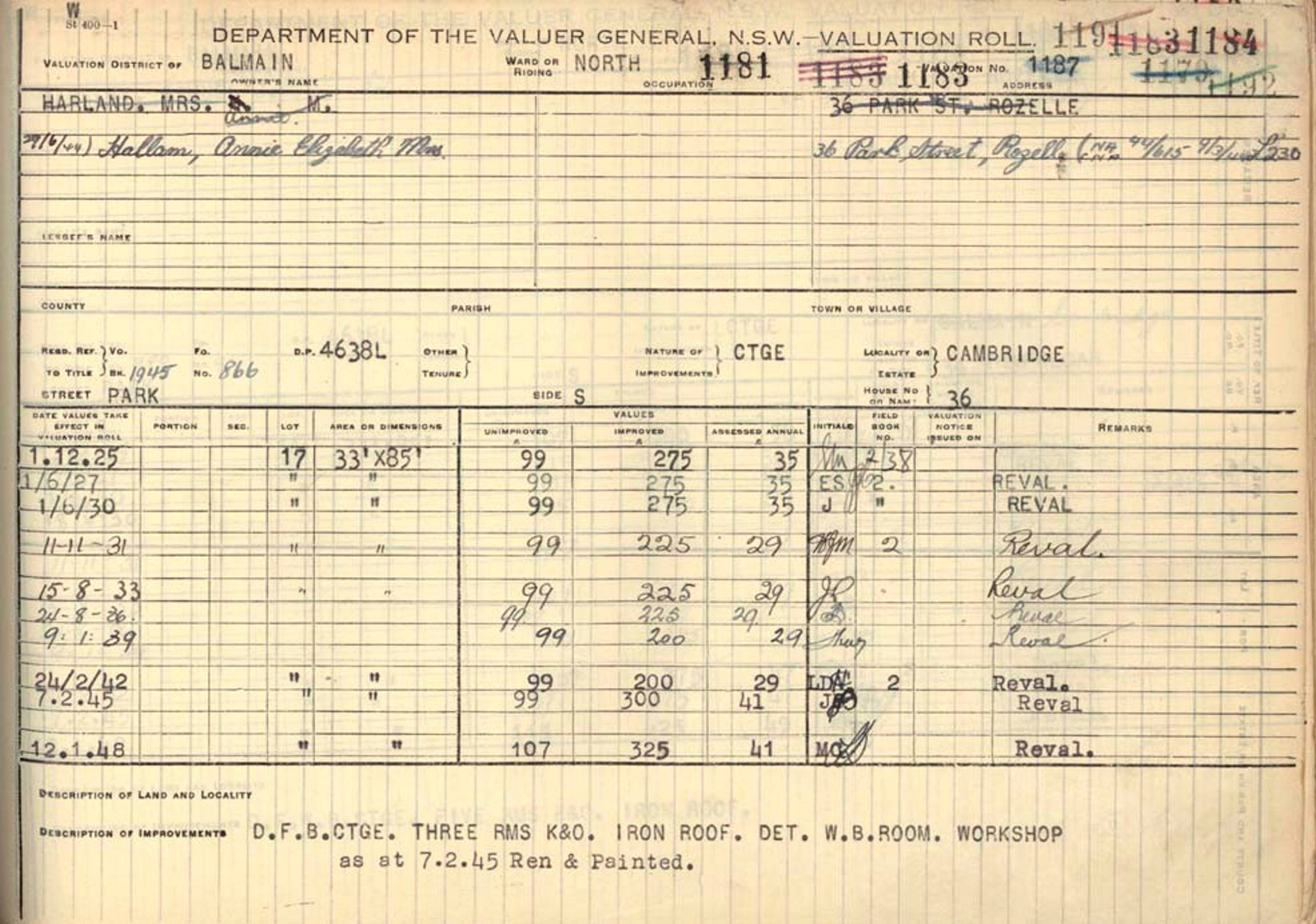
Land valuation guide
Land value refers to the monetary value of the land only and does not include the value of the home or other structures on the land
